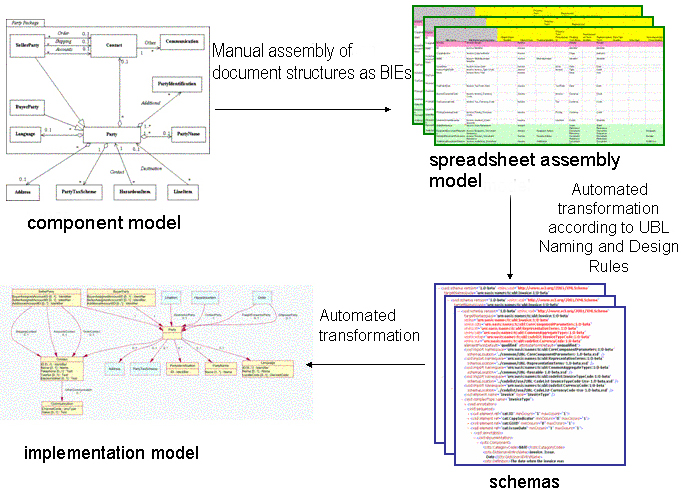A bit long with the diagram, but since we are coming up on the tools meeting, and modeling is in the air, I thought it might be of some interest to see how another TC (ubl) organized its development process, from modeling to schema generation,. This is a diagram for ubl 1.0 model-to-schema process.

(taken from http://docs.oasis-open.org/ubl/cd-UBL-1.0/, Appendix B, Figure B-1)
This shows the relationship of the various work artifacts. The initial component (reference) models were for conceptualization purposes, with the spreadsheet models then assembled by hand. A customized tool applied NDRs to the spreadsheet models to create schema. Once we had the schema there was a tool (hyperModel, http://xmlmodeling.com/) that created UML diagrams from the schema.
As the standard has evolved the process of transforming from spreadsheets to schema has also evolved, but overall the basics remain the same. We almost eliminated the spreadsheets for modeling but could find nothing better in terms of ubiquitous availability and familiarity (the best lowest common denominator, enabling contributions from a broader spectrum of potential users/contributors) and they were generally easy to generate, manipulate, reproduce, share, etc., with no additional ramp-up time. Now, when we get groups wanting to add to the standard, the acceptance criteria is that they deliver the vetted (aligned) content to this spreadsheet format, which then can be automatically transformed into schema.
Here is a link to one of the spreadsheets of the "spreadsheet assembly model" step shown above: http://docs.oasis-open.org/ubl/cd-UBL-1.0/mod/common/UBL-Reusable-1.0.xls .
This one contains the library of common elements (entities) that were 'common' to all the procurement documents being created.
Most of the column names reflect terminology from ISO 11179 Part 1 http://metadata-stds.org/11179-1/ISO-IEC_11179-1_1999_IS_E.pdf .
which is supported by the NDRs and/or CCTS terminology
http://www.unece.org/cefact/ebxml/CCTS_V2-01_Final.pdf .
ISO 11179 is the basis for many data models and data registries, for instance, http://iaspub.epa.gov/sor_internet/registry/datareg/home/overview/home.do
Most columns have an explanatory note popup in the upper right corner of the column header. Some are auto-generated, like the UBL name, using macros. Column 'O' shows cardinality -- required or not, one or many. The Definitions ended up being the basis of an IDD that is now used to localize the standard into a growing number of languages.
One of the schemas created from the above spreadsheet can be seen at
http://docs.oasis-open.org/ubl/cd-UBL-1.0/xsd/common/UBL-CommonAggregateComponents-1.0.xsd
There are many ways to get from here to there, of course, but we found this overall model worked for this particular tc.
Regards,
-Anne